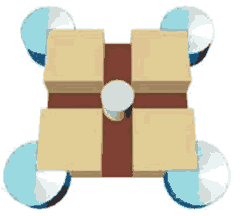
| Château quiz |
| Worksheet 1. |
| Worksheet 2. |
|
Find out how a château was planned and built.
|
Did you know? During the Middle-Ages, very few of the labourers who worked on chateau construction were able to read and write. Even the master masons may not have been fully literate. They would have had great difficulty in reading complex building plans. The masons overcame many of these difficulties by having standardised, traditional measurements that were common across Western Europe. Masons travelled from one big construction to another and their skilled craftsmanship was greatly in demand. To make sure that the buildings were constructed in a stable way, and to ensure a symmetrical design, a geometric module was used by the chateau designer. The module was based on a square calculated to masons’ traditional measurements. This module was then subdivided into a half, a third, a quarter and so on, so that lengths, widths and heights could be easily calculated. The central stairs of the Château de Chambord are designed in a square with 9 metre sides, and this is the "module" for this chateau. This was the basic element which was divided (or multiplied) to calculate the lengths, widths and heights of the rest of the building.
Leonardo da Vinci's famous staircase photographed on the first level. The staircase intricacies provide an interesting puzzle as to which one to take. The interior of the central keep was, therefore, designed on a grid of 45 metres per side, subdivided into modules of 5 x 5 metres. According to the ancients, the Universe was based on invariable (or unchanging) laws of arithmetic and geometry. Consequently, works of art and archtecture had to be governed by the same laws. People considered that symmetry and the correct harmony of proportions were an essential part of this universal concept of beauty. During the Renaissance, people thought that there was nothing more beautiful in the whole Universe than the human form - created by God, in His likeness, and thus, perfection. The materials for the construction of the chateau (wood, stone, etc) were selected according to what was available near the site. This is why châteaux vary so much in appearance from one part of France to another. Much of the decorative work was completed by masons and carpenters who worked off-site. For example, windows, door frames, doors, mantelpieces and stair treads were made in advance – pre-fabricated – and then delivered for installation. This is very similar to what happens nowadays in building a modern house!
|
Constructing a complex building like a château was challenging in an age when few people were literate and work was carried out by hand. Leonardo da Vinci was the mastermind behind the design of the château of Chambord. Click here for the plan of the château
Le château de Chambord - The wonderful château of François 1er.
Source: service éducatif du domain nationale de Chambord
Superimposed on Leonardo da Vinci's perfect "Vitruvian" image of man, the plan for the
|
||
|
|||
Penrose






